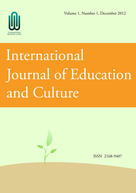


Volume 13 Issues 3-4 (2024-12-31)
Volume 13 Issues 1-2 (2024-06-30)
Volume 12 Issues 3-4 (2023-12-31)
Volume 12 Issues 1-2 (2023-06-30)
Volume 10 Issues 1&2 (2021-06-30)
Volume 9 Issues 3&4 (2020-12-31)
Volume 9 Issues 1&2 (2020-06-30)
Volume 8 Issues 3&4 (2019-12-31)
Volume 8 Issues 1&2 (2019-06-30)
Volume 7 Issues 3&4 (2018-12-31)
Volume 7 Issues 1&2 (2018-06-30)
Volume 6 Issues 3&4 (2017-12-31)
Volume 6 Issues 1&2 (2017-06-30)
Volume 5 Issues 3&4 (2016-12-31)
Volume 5 Issues 1&2 (2016-06-30)
Volume 4 Issues 3&4 (2015-12-31)
This study explored whether a statistically significant relationship existed between aggression and the occurrence of violent crimes and to what extent aggression could predict criminal behaviors. The participants included a cohort of 47 individuals participated in the longitudinal study from the Bangor area in the United Kingdom and spanned ages from three to forty years. The results indicated that there was a statistically significant relationship between aggression and the occurrence of violent crimes. Further, the analysis of childhood aggression’s predictive relationship with future criminal behaviors has evolved significantly.
This study examined the persistent challenges faced by Chinese college students in English listening comprehension, influenced by a combination of linguistic and non-linguistic factors. Focusing on 86 non-English major students from a specific normal university, the research employed the TEM-4 dictation test for English majors and survey questionnaires as tools for empirical investigation. Data collection and analysis revealed four primary factors contributing to the difficulties in English listening comprehension among these students. Based on the findings, the study offered targeted strategies to overcome these barriers, aiming to substantially enhance the overall English listening proficiency of Chinese college students.
Students stand at the crossroads of technological innovation and ethical responsibility. As the primary users of artificial intelligence (AI) tools in academic contexts, they experience firsthand the dilemmas of balancing efficiency with authenticity. While AI can assist students in producing high-quality work, it can also diminish opportunities for them to develop essential writing and critical thinking skills. This article examines how students can strike a balance between using AI and engaging in meaningful learning experiences.
This article explores the significant role of English creative writing in the international dissemination of Chinese culture. In an era of globalization, creative writing in English serves as a medium for conveying Chinese cultural narratives to a wider, global audience. The study examines how the use of English as a lingua franca allows for the adaptation and reinterpretation of Chinese traditions, values, and philosophies, enabling their integration into the global literary landscape. Through case studies of contemporary works by Chinese authors writing in English, the article highlights the challenges and opportunities that arise when bridging cultural gaps. It concludes by emphasizing the potential of English creative writing to act as both a tool for cultural exchange and a platform for reshaping the global perception of China.